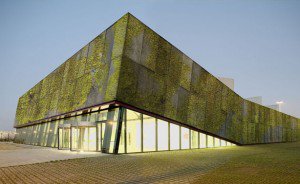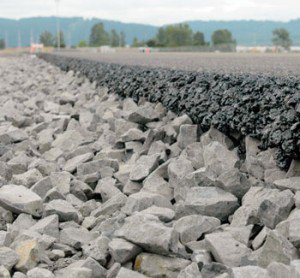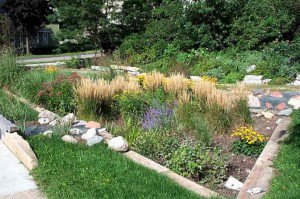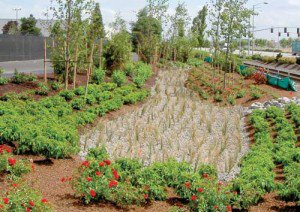By Erica Rascón on June 25, 2013 in News
As capital and operating costs continue to rise, businesses seek creative ways to reduce expenses while passing benefits to their clientele. A solution rests under their feet. Poorly-planned infrastructure leads to long term financial

burdens on businesses and the communities in which they reside. By implementing sustainable infrastructure techniques, businesses can reduce maintenance expenses and minimize the need for infrastructure related tax increases. Such businesses will also appeal to the new generation of consumers who value innovation, sustainability, and responsible growth.
Sustainable storm water management is a commonly overlooked aspect of green building yet it proves to be a worthy foundation upon which any business can establish better practices. A series of studies executed by American Rivers, the Water Environment Federation, the American Society of Landscape Architects and ECONorthwest uncover the numerous benefits of environmentally conscious storm water management. The report, issued by the Sustainable Cities Institute (SCI), concludes that green infrastructure can reduce upfront development costs, minimize the cost of future maintenance, and decimate daily operating costs. Those may seem like high claims for simply redirecting rainwater, but the evidence proves to be compelling.
A new perspective on age-old problems
Traditional urban planning treats storm water as a problem that requires billions in funds to rectify. A new line of thought approaches storm water as an asset that can be used to reduce operating costs and beautify man-made sites. The premise of the new mindset is simple: capture and treat water where it falls, rather than channeling it to a centralize system. In doing so, the water’s power may be harvested and the challenges of transporting contaminated runoff are minimized.
Businesses interested in alternative infrastructure have several green options from which to choose, including porous pavement, street trees, green roofing, rain gardens and water harvesting. Techniques may be implemented individually but often reap greater benefits when used together.

Leading in overall cost savings, porous pavement allows water to be stored where it falls rather than gathering and channeling it to a peripheral location. The material reduces salt maintenance during freezes and reduces the threat of flooding. Upfront material costs for porous roadways are more expensive than traditional asphalt or concrete, yet the associated construction costs, curbing, erosion control and drainage infrastructure are more affordable, creating a less costly package overall. Porous pavement requires less material; cited costs for the green streets project in Seattle were reduced by 49 percent. Permeable pavements are also 3-6 times more efficient for managing storm water, as demonstrated by Chicago’s Green Alleys program in the SCI report.
Second in savings, street-level vegetation lining roadways, parking lots, and walkways is a relatively simple and beautiful way to minimize strain on the sewer system and the costly repercussions that follow. Trees, water gardens, and other plant life utilize natural hydrological functions to offset run damage. In addition, the plants help to naturally filter water that feeds into ground sources. The SCI publication suggests that increasing street and neighborhood trees for cleaner water may save American commercial and industrial energy users approximately $10 billion in water treatment expenses.
Green roofs have shown to reduce businesses expenses in multiple areas. By replacing tiles, shingles or concrete with plants, the roof of a building becomes a force for minimizing storm water runoff. Well-planned green roofs use and store water without damage to the building; in fact, the plants serve as insulation for the building that can be used to lower utility costs. Vegetation lowers the absorption of solar radiation; plants conduct less heat than traditional roofing materials, making the average green roof 60F cooler than traditional roofs during the summer. As a result, green roofs notably reduce the energy needed to heat and cool buildings. Recent developments in green building, such as organic concrete, allow new builds and existing structures to place the cost-saving power of green roofing onto vertical surfaces, increasing energy efficiency.
Successful green roof projects have been completed through Europe and North America. Notable American projects include The City of Chicago, which installed a green roof on half its City-County building. The project yields an anural $3,600 in energy savings for the building. FedEx adapted green roofs to its 175,000 square-foot facility at O’Hare Airport of Chicago. The project harvests nearly two million gallons of storm water each year, and resulted in annual energy savings of about $35,000. These savings come in addition to federal and local incentives for sustainable building. Many cities offer rebates and incentives to businesses—sometimes as high as 25 percent—to install green roofing.
Lastly, water harvesting stores rainwater for later use in landscape irrigation, exterior cleaning, and other non-potable applications. The harvested water makes practical use of water that would otherwise contribute to problematic runoff. There are a range of harvesting system available, each customizable to the needs of specific sites. Recycled rainwater can save commercial users nearly 80 percent in water costs. The SCI report contains a feasibility study on rainwater harvesting conducted at Texas A&M University. The institution could save $406,000 each year by installing 43 rainwater harvesting systems throughout the vast campus.
While individual buildings may reap the benefit of lower utility bills, the benefits of green infrastructure are seen on a much larger scale. A portion of the SCI report focused on energy savings in California. Adopting green infrastructure could save Los Angeles County 428,000 MWH in energy costs, which could power anywhere from 20,000 and 64,800 households. These saving come via an increase in groundwater supplies, which decreases the need to import up to 152,500 acre-feet of water each year, every year, until 2030; recharge from sustainable building could save the city $23,112,000 annually.
Throughout the state, the implementation of sustainable infrastructure could save over 1.2 million megawatt-hours of electricity each year that would normal go towards heating and cooling. That is enough to power 102,000 single-family homes year round.

Lowering upfront and overall costs
Sustainability advocates face the challenge of overcoming common misconceptions about green building; many assume new technologies and methods are inherently more costly or that eons must pass before returns on investments can be reaped. Neither is correct.
Green infrastructure can be more cost effect and inexpensive than comparable, gray water systems. The SCI study cites an U.S. EPA report that tracked the cost of 12 infrastructure projects. 11 of the 12 green projects resulted in lower total costs than equivalent conventional projects. Furthermore, natural conveyance systems decreased structural cost throughout the storm water management system for the area.
Sustainable infrastructure offers cost-saving customizations that are not available through prescribed gray water management systems. Businesses save on land acquisition, built capital, and external costs imposed by third parties; by adapting water maintenance systems to each unique site, developers avoid costly gray infrastructure installation and maintenance costs that may not adequately meet, or exceed, the needs of the site.
The cost to treat combined sewage volumes also decrease. Municipalities and utilities impose storm water controls to regulate the volume of water that must be treated for pollutants. The on-site capture and treatment of water reduces (and in some cases, eliminates) treatment costs. By mitigating the rise of treatment costs, municipalities and utilities stand a better chance of controlling costs as demand for depleting energy supplies continue to rise; these savings are passed on to individual businesses and other consumers.
Systems needed for treating, heating and transporting water are noted as some of the nation’s highest energy consumers, composing more than 3 percent of US energy usage each year. Cities, as well as individual businesses, could save money with green infrastructure. The City of Portland has avoided conveyance costs of $100,000 per year since the completion of the Swan Island CSO Pump Station, which helps to manage water through the use of green infrastructure.
There are instances where green water management requires more upfront investment than traditional systems. The notably inexpensive, though more frequent, maintenance required of green systems often offsets initial costs. The ASLA storm water study concludes that the “total benefits outweigh the total costs, particularly relative to grey infrastructure strategies and at comparable scales.”
Maintenance savings for businesses
The Federal Emergency Management Agency (FEMA) estimates that 25% of its annual flood damage claims are linked to localized storm water flooding. Such floods result in costly property damage that can be minimized, if not prevented, by amplifying green infrastructure that promotes water infiltration and retention.

Storm water management that relies on the natural hydrological relationship between water and vegetation reduces strain on existing storm water infrastructure. Water is absorbed by the vegetation, resulting in less runoff in sewer systems. Without excessive strain, existing storm water management systems can operate effectively, longer, without the risk of flooding. Less flooding may result in fewer unfavorable tax hikes on businesses and consumers to compensate for restructuring and repairs.
For individual businesses, quality green infrastructure often requires more frequent maintenance yet operations are less expensive and less time consuming than maintenance on traditional systems. The benefit of infrequent gray water system maintenance is often offset by the exorbitant expense of the intensive repairs. Such processes can close or inhibit businesses for weeks. Overtime, the cost of conventional maintenance will increase as materials wear down. In contrast, green infrastructure is designed to become more resilient with age, serving its function better, with less effort. Data from Seattle Public Utilities indicates that The Natural Drainage Projects in Seattle yielded a cost savings of $329 per square foot over conventional construction during its construction. Additionally, the green infrastructure has proved to be more cost-effective overtime as it has become a nearly self-sustaining system.
Joint effort, broader savings
New and existing commercial sites stand to reap the financial benefits of green infrastructure. When sustainable practices are implemented citywide, the benefits reach farther into the community and local economy.
In addition to integrating sustainable storm water maintenance in commercial expansion plans, firms may consider contacting local representatives, builders, and investors to begin a dialogue about the potential benefits of green infrastructure in the community.


